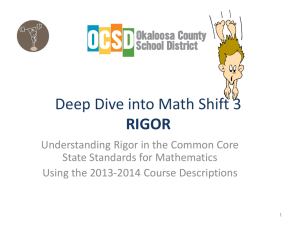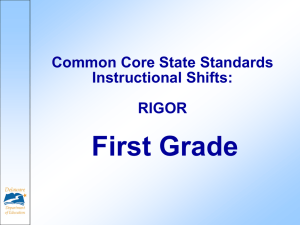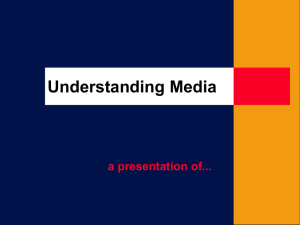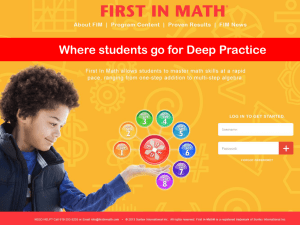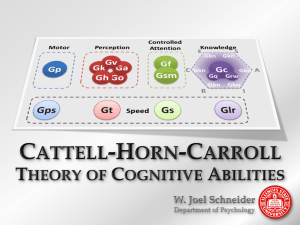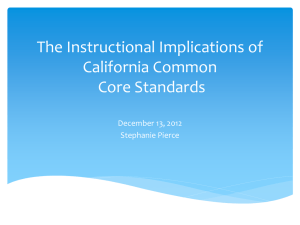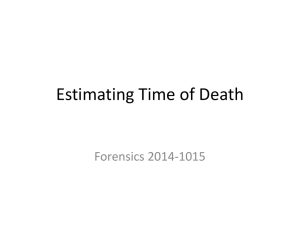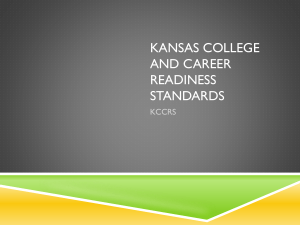Rigor May 2nd Middle School
advertisement
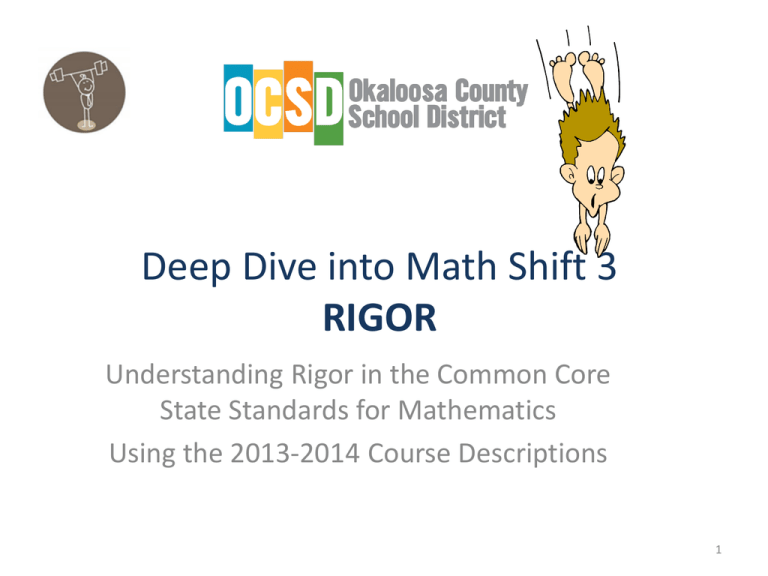
Deep Dive into Math Shift 3 RIGOR Understanding Rigor in the Common Core State Standards for Mathematics Using the 2013-2014 Course Descriptions 1 Shift #3: Rigor What is meant by rigor? • The CCSSM require a balance of: Solid conceptual understanding Procedural skill and fluency Application of skills in problem solving situations • Pursuit of all three requires equal intensity in time, activities, and resources. RIGOR Today’s Agenda Rigor in the CCSSM 1. Discuss Rigor and Find evidence of it within the 2013-2014 Florida Math Course Descriptions 2. Look specifically at fluency recommendations for Middle School 3. Determine what instructional shifts must occur as we increase the rigor 3 Building Fluency What is meant by fluency? Mathematics Fluency: A Balanced Approach (1:56) http://www.youtube.com/watch?v=ZFUAV00bTwA&list=PLD7F4C7DE7 CB3D2E6&index=13&feature=plpp_video http://youtu.be/ZFUAV00bTwA 4 Fluency What is it? Skill in carrying out procedures flexibly, accurately, efficiently and appropriately What the Student Does… What the Teacher Does… •Spends time practicing, with intensity, skills (in high volume) •Pushes students to know basic skills at a greater level of fluency •Focuses on the listed fluencies by grade level •Uses high quality problem sets, in high volume 5 Deep Understanding What is it? Comprehension of Mathematical Concepts What the Student Does… What the Teacher Does… •Shows mastery of material at a deep level •Responds to student answers by eliciting student explanations and reasoning •Articulates mathematical reasoning •Demonstrates deep conceptual understanding of priority concepts •Ensures that all students reach understanding •Views concepts being taught as a coherent continuum instead of as isolated topics 6 What the Student Does… What the Teacher Does… •Applies math in other content areas and situations, as relevant •Applies math content to other content areas (i.e. science) •Chooses the right math concept to solve a problem when not necessarily prompted to do so •Provides students with real world experiences and opportunities to apply what they have learned 7 Rigorous Group Discussion 1. Share examples of relevant, real-world experiences you use to make important connections to the concepts you teach. 2. How do these applications relate back to both fluency and conceptual understanding? 8 One Instructional Model Assuming a 60 minute math class: 10 minutes: Fluency Activities, formative assessment 20 minutes: Conceptual Development/Practice 20 minutes: Application 10 minutes: Review 9 EXAMPLE: NY Common Core Mathematics Curriculum Model Lesson Structure 10 How do we address rigor while building fluency? Rigor Breakdown - Sprints - Fluency in Action(6:07) http://www.engageny.org/resource/nti-november-2012-rigorbreakdown-sprints-fluency-in-action 11 Florida 2013-2014 Math Instruction • Blended Instruction between the CCSS and a subset of NGSS (assessed by FCAT 2.0). • Grades 3-8 will be assessed by FCAT 2.0 • Algebra I and Geometry will be assessed by the Florida EOC Exams. Transitional Shifts • Increased rigor • Classroom assessment to include PARCC-like tasks 12 Rigor Addressed in the Standards • Conceptual Understanding: 6.NS.3.7 Understand ordering and absolute value of rational numbers. • Procedural Skill and Fluency: 7.EE.2.4a …..Solve word problems leading to equations of the form px + q = r and p(x + q) = r, where p, q, and r are specific rational numbers. Solve equations of these forms fluently… • Application: 8.G.3.9 Know the formulas for the volumes of cones, cylinders, and spheres and use them to solve real world and mathematical problems. 13 Rigor Requires Balance Conceptual Understanding + Procedural Skill and Fluency + Application = RIGOR 14 Evidence of Rigor in the Standards key words within the standards Conceptual Understanding Understand Describe Relate Justify Recognize Explain Represent Solve Interpret Use Identify Procedural Skill and Fluency Fluently Fluency Application Solve Real World Problem Mathematical Problem Word Problem Apply Model(ing) 15 Locating Evidence of Rigor in the Standards In grade-level teams: • Read each standard in your course description • Look for and underline or highlight key words or phrases indicating RIGOR – Understand – Fluently – Solve Real World problems or word problems • Post your questions and comments to the Parking Lot 16 RIGOR is a Balancing Act RIGOR 17 Grade Standard Key Fluency K MACC.K.OA.1.5 Add/subtract within 5 1 MACC.1.OA.3.6 Add/subtract within 10 MACC.2.OA.2.2 Add/subtract within 20 2 MACC.2.NBT.2. Add/subtract within 100 (pencil and paper) 5 MACC.3.NBT.1. Add/subtract within 1,000 3 2 Multiply/divide within 100 MACC.3.OA.3.7 MACC.4.2.4 Add/subtract within 1,000,000 4 Critical Area #1 Develop fluency with efficient procedures for multiplying whole numbers MACC.5.NBT.2. Multi-digit multiplication 5 5 Developing fluency with addition and subtraction of Critical Area #1 fractions 6 7 8 MACC.6.NS.2.2 MACC.6.NS.2.3 MACC.7.EE.2.4 a MACC.8.EE.3.8 b Multi-digit division Multi-digit decimal operations Solve px + q = r, p(x + q) = r Solve simple 22 systems by inspection Advance to next slide Grade 6 Fluency Progression Interpret and compute quotients of fractions and solve word problems involving division of fractions by fractions. 6.NS.1.1 Fluently divide multi-digit numbers using the standard algorithm. 6.NS.2.2 Fluently add, subtract, multiply, and divide multi-digit decimals using the standard algorithm for each operation. 6.NS.3 19 Grade 7 Fluency Progression Apply and extend previous understandings of operations with fractions to add, subtract , multiply, and divide rational numbers. 7.NS.1.1–2 Students solve multistep problems posed with positive and negative rational numbers in any form (whole numbers, fractions, and decimals), using tools strategically. 7.EE.2.3 Solve word problems leading to onevariable equations of the form px + q = r and p(x + q) = r, fluently. 7.EE.2.4a 20 Grade 8 Fluency Progression Solve linear equations in one variable. 8.EE.3.7 Analyze and solve pairs of simultaneous linear equations....Solve simple cases by inspection. 8.EE.3.8b 21 Rethinking Rigor • Building Confidence through Problem Solving • Grades 3-5, Math, Number Fluency https://www.teachingchannel.org/videos/buildingmath-confidence 22 Group Discussion Where was the rigor? What strategies and structures are applicable to MS? What shifts need to happen in our classrooms? 23
